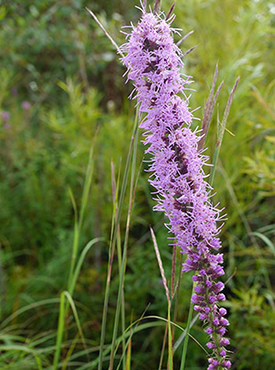Dense Blazing Star

Species information
The following is a report on progress made towards the protection and recovery of Dense Blazing Star, (Liatris spicata) in Ontario from 2007 to 2020, based on Ontario’s species-specific recovery policy. This report meets the legislative requirement for a review of progress under the Endangered Species Act, 2007 (ESA or “the Act”). Dense Blazing Star is listed as threatened on the Species at Risk in Ontario (SARO) List under the ESA.
Dense Blazing Star has been classified as a species at risk since 2004. It was originally classified as a threatened species and was listed as such under the ESA when it came into force in June 2008.
Dense Blazing Star has been protected from being killed, harmed, harassed, captured or taken since 2008.
In addition, the habitat of Dense Blazing Star has been protected from being damaged or destroyed since 2013.
The species-specific recovery policy for Dense Blazing Star, known as the Government Response Statement (GRS) was published in 2016 and includes the government’s recovery goal for the species and the actions and priorities it intends to lead or support to help achieve that goal. The GRS considers science advice provided in the recovery strategywhen developing recovery actions for the species. As legislated in the Act, the purpose of this review is to report on progress made towards implementing the protection and recovery actions in the GRS. The review can also help identify opportunities to adjust and adapt the implementation of protection and recovery actions to achieve the recovery goal for the species.
Further information about Dense Blazing Star, including the threats that it faces, and actions being taken to help protect and recover this species is available on the Government of Ontario webpage for Dense Blazing Star. A summary on the progress towards the protection and recovery of Dense Blazing Star and an annual update on the species at risk program (i.e. the Introduction to the 2021 Review of Progress report) is available on the Review of Progress towards the Protection and Recovery of Ontario’s Species at Risk webpage.
Snapshot: Progress towards the protection and recovery of Dense Blazing Star
Progress towards meeting the recovery goal
- The recovery goal in the Government Response Statement (GRS) for Dense Blazing Star in Ontario is to “maintain the distribution and abundance of Dense Blazing Star in Ontario and support natural increases in the abundance of Dense Blazing Star at existing viable locations. The government supports investigating the feasibility of augmenting existing populations deemed to be non-viable in the absence of additional recovery efforts.”
- Progress has been made towards implementing all of the government-led actions. Progress has been made towards implementing all of the government-supported recovery objectives and a majority of the associated actions. Examples of progress include:
- management of Dense Blazing Star habitat through methods such as prescribed burning and deer population control
- implementation of Ontario’s Invasive Species Strategic Plan, to reduce the impacts of invasive species, such as European Common Reed and Purple Loosestrife, that threaten Dense Blazing Star
- workshops and educational signage to promote awareness of Dense Blazing Star and its habitat
- In alignment with the GRS, continued effort is required to implement a standardized monitoring protocol at existing populations of Dense Blazing Star. Research and monitoring is required to assess the viability of populations with low numbers of individual plants and to determine whether any of the populations of unknown origin consist of plants native to Ontario.
Occurrences and distribution
- Dense Blazing Star is limited to southwestern Ontario, in the regions between Lake Erie, Lake St. Clair, and Lake Huron, with a distribution of 152 square kilometres based on recent observations, and an additional 153 square kilometres based on historical observations.
- The Natural Heritage Information Centre (NHIC) has received nearly 1,760 observations of the species based on observations made between 1884 and 2020.
- Since 2008, the species has been observed in multiple locations where it was not previously known to occur. Based on up-to-date information, the species’ extant distribution is estimated to encompass an area 82 square kilometres larger than was known since the ESA came into effect.
Government-supported stewardship projects
- Through the Species at Risk Stewardship Program, the Government of Ontario has enabled its stewardship partners to conduct 41 projects (by providing $1,965,607 in funding) that have supported the protection and recovery of multiple species at risk, including Dense Blazing Star.
- The government’s support helped its stewardship partners to involve 1,881 individuals who volunteered 18,719 hours of their time towards protection and recovery activities for species at risk, including Dense Blazing Star. The estimated value of these voluntary contributions, as well as additional funding and in-kind support, is $3,465,160.
- Stewardship partners reported that through their actions 483 hectares of habitat were enhanced for Dense Blazing Star and other species at risk that inhabit the same ecosystem.
- Stewardship partners reported providing outreach on multiple species at risk, including Dense Blazing Star, to 1,157,681 individuals.
Supporting human activities while ensuring appropriate support for species recovery
- The Government of Ontario has issued nine permits for this species: seven ‘protection or recovery’ permits were issued under clause 17(2)(b), one ‘overall benefit’ permit was issued under clause 17(2)(c), and one ‘social and economic benefit’ was issued under clause 17(2)(d) of the ESA.
- Ten agreements were entered into for Dense Blazing Star. These agreements were enabled through Ontario Regulation 242/08 (prior to the July 1, 2013 amendment).
- Sixty-seven activities have been registered for the species. The activities were registered under ‘Notice of drainage works’ (section 23.9), ‘Ecosystem protection’ (section 23.11), ‘Hydro-electric generating stations’ (section 23.12), ‘Species protection or recovery’ (section 23.17) and ‘Threats to human health or safety, non-imminent’ (section 23.18) under Ontario Regulation 242/08 of the ESA.
Reporting on the progress towards the protection and recovery of Dense Blazing Star
Recovery goal
The government’s goal for the recovery of Dense Blazing Star is to maintain the distribution and abundance of Dense Blazing Star in Ontario and support natural increases in the abundance of Dense Blazing Star at existing viable locations. The government supports investigating the feasibility of augmenting existing populations deemed to be non-viable in the absence of additional recovery efforts.
The implementation of government-led and government-supported actions demonstrates progress towards reaching the desired objectives and the recovery goal set out in the GRS.
Progress towards implementing government-led actions
Progress has been made towards implementing all government-led actions identified in the GRS. Common actions for the government to lead as it works towards achieving a species’ recovery goal include:
- Co-operate with federal partners, such as Environment and Climate Change Canada, to implement protection and recovery actions, where appropriate.
- Educate other agencies and authorities involved in planning and environmental assessment processes on the protection requirements under the ESA.
- Encourage the submission of Dense Blazing Star data to the Government of Ontario’s central repository at the Natural Heritage Information Centre.
- Undertake communications and outreach to increase public awareness of species at risk in Ontario.
- Protect Dense Blazing Star and its habitat through the ESA.
- Develop direction to provide greater clarity to proponents and partners on the areas of general habitat protected under the ESA for species at risk plants.
- Support conservation, agency, municipal and industry partners, and Indigenous communities and organizations to undertake activities to protect and recover Dense Blazing Star. Support will be provided where appropriate through funding, agreements, permits (including conditions) and/or advisory services.
- Encourage collaboration, and establish and communicate annual priority actions for government support in order to reduce duplication of efforts.
Additionally, the government has directly undertaken the following species-specific actions:
- Continue to manage the habitat of Dense Blazing Star in The Pinery Provincial Park and Ojibway Prairie Provincial Nature Reserve to maintain or improve suitability for the species using appropriate methods (e.g., modifications to enclosure fencing, redirecting recreational activities to other areas, removal of woody vegetation, prescribed burning).
- Continue to implement the Ontario Invasive Species Strategic Plan to address the invasive species (e.g., European Common Reed, White Sweet Clover, and Purple Loosestrife) that threaten Dense Blazing Star.
Key progress made towards implementing these actions is described in the following sections.
Ontario Parks continues to monitor and manage species at risk habitat at Pinery Provincial Park to maintain ecological integrity and minimize the threat of recreational pressures. Action undertaken by Ontario Parks includes management of Dense Blazing Star habitat through prescribed burning, invasive species control and deer population management. Ontario Parks also contributes to Dense Blazing Star protection at Ojibway Prairie Provincial Nature Reserve through prescribed burning and invasive species management.
Ontario’s Invasive Species Act
The GRS for Dense Blazing Star indicates that invasive species (e.g. European Common Reed, White Sweet Clover and Purple Loosestrife) pose a threat to the survival and recovery of the species in Ontario. The Ontario Invasive Species Strategic Plan, 2012 and the Invasive Species Act, 2015 provide the policy and legislative framework to prevent new invaders from arriving and surviving in Ontario; to slow and where possible reverse the spread of existing invasive species, and to reduce the harmful impacts of existing invasive species, including impacts on species at risk. This framework may support the implementation of actions to reduce the threats from invasive species.
Occurrences and distribution
Dense Blazing Star is limited to southwestern Ontario, in the regions between Lake Erie, Lake St. Clair, and Lake Huron. For this review of progress, the species’ occurrence information has been assessed at a landscape scale using one by one kilometre grid “squares” to approximate the species’ distribution. The squares were used to estimate where the species has been recently observed (i.e., has been observed within the past 20 years) as well as squares where the species is considered historical.
Using this approach, the species has been recently observed in 152 squares, and there are153 additional squares with historical observations of the species. This equates to a potential range
The NHIC has received nearly 1,760 records of Dense Blazing Star. The records are based on observations between 1884 and 2020. Based on records since 2008, the species has been observed in locations associated with 82 squares in which it was not previously known to occur, and the species’ presence has been re-confirmed in 58 additional squares.
This enlargement of the species’ estimated distribution is likely in part due to intentional planting of the species outside its native range. The increase in distribution may also in part be the result of increased search effort and education about Dense Blazing Star and represents increased knowledge on the distribution of the species. Efforts to engage citizen scientists in collecting data for these species have increased since 2008, with an assortment of programs and tools available for observations to be submitted and confirmed.
Encouraging the submission of observations of this species is included in the GRS as a government-led action. Submission of species observations increases our knowledge of where they occur and can play an important role in assessing the viability of species’ populations.
Everyone is encouraged, or may be required by an authorization or approval, to submit observations of Dense Blazing Star, and any other species at risk, to the NHIC for incorporation into the provincial record of observations. Observations may now be submitted to NHIC via the Rare Species of Ontario project in iNaturalist.
-
1,183observations of this species were submitted to the NHIC since 2004
Government-supported stewardship projects
An important government-led action in the GRS for Dense Blazing Star is to support partners to undertake activities to protect and recover the species. Through the Species at Risk Stewardship Program the government has supported 41 projects ($1,965,607) designed to contribute to the protection and recovery of multiple species at risk, including Dense Blazing Star
Stewardship partners reported that provincial funding helped them to secure in-kind support by involving 1,881 individuals who volunteered 18,719 hours of their time towards protection and recovery activities for multiple species at risk, including Dense Blazing Star, which has an estimated value of $522,913. Partners also reported that through both their efforts and the efforts of their volunteers to implement GRS actions, they were successful in enhancing 483 hectares of habitat that will benefit multiple species at risk, including Dense Blazing Star. In addition, stewardship partners reported providing ecosystem-based outreach on multiple species, including Dense Blazing Star, to 1,157,681 individuals.
The remainder of this section highlights two projects supported through the Species at Risk Stewardship Program as well as the corresponding government-supported recovery actions for the species.
As part of a two-year project focused on prairie species at risk, collaborating organizations implemented a habitat management project at the Ojibway Prairie Complex in southwestern Ontario. Volunteers and collaborating local jurisdictions enhanced habitat by conducting prescribed burns and removing invasive species and encroaching woody species. This work created favourable conditions for Dense Blazing Star and other native prairie species and contributed to the high priority GRS action to develop and implement plans to maintain and improve habitat quality for Dense Blazing Star (Action No. 5).
A project led by the Carolinian Canada Coalition from 2013-2015 contributed to multiple GRS actions to benefit Dense Blazing Star and other species at risk. By creating action plans for properties in Elgin County, Chatham-Kent, and other sites in Canada’s Carolinian zone, the project contributed to habitat improvement efforts for multiple species at risk, including Dense Blazing Star. Another component of this project was the EcoTrails initiative, which included targeted development of walking trails near species at risk sites. By redirecting recreational activities away from sensitive species and designing educational signage, EcoTrails contributed to the GRS action to implement approaches to avoid or minimize the impacts of recreational activities on Dense Blazing Star (Action No. 7). This initiative also supported progress towards implementing the action to promote awareness about Dense Blazing Star (Action No. 9) and other species at risk through a range of outreach activities, including youth camps and workshops, landowner engagement, and a natural heritage inventory.
Species at Risk Stewardship Program
-
 41
41projects included Dense Blazing Star
-
 $1,965,607
$1,965,607for multi-species projects that included Dense Blazing Star
-
 $3,465,160
$3,465,160in additional funding and in-kind support
-
 1,881
1,881volunteers
-
 18,719
18,719volunteer hours
-
 1,157,681
1,157,681people received outreach
-
 483
483hectares of habitat enhanced
Supporting human activities while ensuring appropriate support for species recovery
Supporting partners through authorizations and their associated conditions is an important government-led action.
Nine permits have been issued for Dense Blazing Star since the species has been protected under the ESA: seven ‘protection or recovery’ (17(2)(b)) permits, one ‘overall benefit’ (17(2)(c)) permit and one ‘social and economic benefit’ (17(2)(d)) permit.
‘Protection or recovery’ permits are issued if the purpose of the activity is to assist in the protection or recovery of a species at risk. Of the seven ‘protection or recovery’ permits, six were issued exclusively for Dense Blazing Star and one was issued for multiple species, including Dense Blazing Star. These permits enabled a variety of organizations to undertake activities for the species such as seed collection, propagation and transplantation to restoration areas.
One ‘overall benefit’ permit was issued for Dense Blazing Star. This permit was issued for multiple species, including Dense Blazing Star, at a development site where Dense Blazing Star occurs. Several of the conditions included in the permit were designed to benefit Dense Blazing Star, including:
- Collecting seeds for the purposes of propagation, at a ratio of four new plants for every one found within the development site.
- Transplanting Dense Blazing Star to a nearby restoration area.
- Enhancing habitat within the restoration area through removal of invasive species, transplantation of suitable topsoil and seeding with native tallgrass prairie seed mix.
Other conditions designed to minimize adverse effects include:
- Providing species awareness training for all personnel working at the site.
- Undertaking activities such as transplantation during the time of year when plants are least sensitive to disturbance.
More detailed information regarding ‘overall benefit’ permits for this species is available through the Environment Registry of Ontario.
A ‘social and economic benefit’ (17(2)(d)) permit was issued for multiple species, including Dense Blazing Star, as part of the authorization process for the construction of enhanced international border crossing infrastructure between Windsor and Detroit. The ‘social and economic benefit’ permit was issued to the Ontario Ministry of Transportation for multiple species at risk, including Dense Blazing Star. The permit was one of the authorizations issued for the construction of the Right Honorable Herb Gray Parkway, the access road portion of a new end-to-end border transportation system between Windsor, Ontario and Detroit, Michigan.
Although the main purpose of an activity authorized by a 17(2)(d) permit is not to assist in the protection or recovery of the species, the Minister must be of the opinion that the activity will result in a significant social or economic benefit to Ontario. The Minister must also be of the opinion that the activity will not jeopardize the survival or recovery of the species in Ontario, that reasonable alternatives have been considered, and that reasonable steps to minimize adverse effects on the individual members of the species are required by the conditions of the permit.
In this permit, general conditions to minimize adverse effects on the species included:
- Providing all workers on the site with a fact sheet identifying each of the species at risk named in the permit and species-specific guidance on appropriate actions to be taken whenever a member of these species is encountered.
- Ensuring that before any person begins carrying out any mitigation or monitoring activities authorized by the permit, the person receives training on relevant species at risk by persons authorized by the government.
The permit also included more detailed conditions such as:
- Developing and implementing an approved Dense Blazing Star restoration and management plan that provides detailed information with respect to restoration activities, including: i) seed collection; ii) seed propagation techniques; iii) seedling planting techniques and management; iv) transplanting techniques and management; and v) habitat restoration, enhancement and creation techniques for restoration sites.
- Collecting seed from Dense Blazing Star individuals within the construction site for the purpose of propagating a minimum of five new Dense Blazing Star seedlings for each individual impacted.
- Removing all Dense Blazing Star individuals within the construction site and transplanting them to restoration sites.
- Providing annual monitoring reports to the government for each planted or transplanted Dense Blazing Star individual that includes: i) date of planting or transplanting; ii) date and type of tending; iii) health status of planted individuals; and iv) whether natural reproduction is occurring.
Ten agreements were entered into for Dense Blazing Star. These agreements were enabled through Ontario Regulation 242/08 (prior to the July 1, 2013 amendment). Conditions of the agreements involve creating a mitigation plan and implementing actions in the mitigation plan, including, but not limited to:
- Taking reasonable steps to minimize the adverse effects of the activities on the species.
- Monitoring, collecting and maintaining information on the species and the mitigation measures taken.
- Submitting an annual report summarizing the results and the effectiveness of the work.
Sixty-seven activities that may affect Dense Blazing Star or its habitat have been registered for the purposes of Ontario Regulation 242/08 under the ESA. Ten activities were registered under ‘Notice of drainage works’ (section 23.9), five activities under ‘Ecosystem protection’ (section 23.11), one activity under ‘Hydro-electric generating stations’ (section 23.12), eight activities under ‘Species protection or recovery’ (section 23.17) and 43 activities under ‘Threats to human health or safety, non-imminent’ (section 23.18). These registrations require the registrant to comply with all conditions of the regulation, such as:
- Preparing a mitigation plan using the best available information on steps that may help minimize or avoid adverse effects on the species.
- Taking reasonable steps to minimize the adverse effects of the activity on a species, such as relocating members of the species to nearby suitable habitat, if feasible.
- Reporting observations of the species using the Ontario Species at Risk Observation Reporting Form and submitting them to the NHIC.
-
1social or economic benefit permit
-
7protection or recovery permits
-
1overall benefit permits
-
10agreements
-
67registrations
Progress towards implementing government-supported actions
Government-supported actions are organized under overarching recovery objectives. Progress has been made towards achieving all government-supported recovery objectives and implementing a majority of the associated actions identified in the GRS for Dense Blazing Star.
Objective: Increase knowledge of the biology, distribution and current population status of Dense Blazing Star.
- Action No. 1 (High Priority) – Develop and implement a standardized monitoring protocol at existing populations of Dense Blazing Star to document changes to population sizes, demographic changes, reproductive success, threats, and habitat quality. Facilitate collaborative sharing of monitoring data.
- Action No. 4 – Encourage the recording, sharing and transfer of Traditional Ecological Knowledge on Dense Blazing Star as available, including information on the historical distribution of the species and conditions of its habitat (e.g., the historical frequency of wildfire within the species' habitat) to inform survey protocols and habitat management actions. Coordinate this with efforts for other species at risk plants which occur in the same ecosystem.
Under this objective, initial progress has been made towards implementing Action No. 1 and progress has been made towards implementing Action No. 4. The first action has been implemented through projects supported by the Species at Risk Stewardship Program that have included species at risk inventories in Dense Blazing Star habitat. Progress towards Action No. 4 has been achieved through three projects undertaken through the Species at Risk Stewardship Program. These projects promoted the sharing of Traditional Ecological Knowledge on multiple species at risk, including Dense Blazing Star, with an emphasis on youth engagement in Walpole Island First Nation.
Objective: Maintain or improve the quality of the habitat to support natural increases to the abundance of Dense Blazing Star at each of the locations where it exists in Ontario.
- Action No. 5 (High Priority) – Develop, implement and evaluate the effectiveness of management plans to maintain or improve the quality of habitat available for Dense Blazing Star. Plans may include practices such as:
- removal of invasive plants (e.g., European Common Reed, White Sweet Clover, and Purple Loosestrife), woody vegetation and other plants that compete with Dense Blazing Star
- changes to mowing schedules or herbicide applications
- prescribed burning as appropriate, and if evaluated to be beneficial for the species
- Action No. 6 – Develop, implement and evaluate approaches to avoid or minimize the impacts of land development and associated infrastructure projects on Dense Blazing Star and its habitat (e.g., projects that have potential to alter drainage and soil conditions in the habitat of the species, such as installation or modification of ditches or drainage tile, paving, or soil compaction).
- Action No. 7 – Implement and evaluate approaches to avoid or minimize the impacts of recreational activities on Dense Blazing Star and its habitat, including:
- redirecting recreational activities away from the species
- erecting physical barriers
- installing signage to alert people to the presence of the species
Under this objective, considerable progress has been made towards implementing Action No. 5 and Action No. 6, and progress has been made towards implementing Action No. 7. Implementation of Action No. 5 has been achieved through multiple habitat restoration and enhancement projects supported by the Species at Risk Stewardship Program. These projects include the development and implementation of a range of techniques to improve habitat quality for Dense Blazing Star and other species at risk, such as prescribed burns and development of best management practices for invasive species control. Progress towards Action No. 6 has been achieved through conditions of ESA authorizations and agreements requiring proponents to develop, implement and evaluate mitigation plans to minimize impacts on Dense Blazing Star while working within its habitat. A project that included development of a recreational trail and signage also contributed towards Action No. 7.
Objective: Increase local awareness of activities that threaten Dense Blazing Star and encourage sharing of information on methods to reduce threats.
- Action No. 8 – Synthesize and distribute best management practices to municipalities, railway and utility companies and other organizations working in the habitat of Dense Blazing Star on methods to mitigate impacts of vegetation management and maintenance activities on the species and its habitat.
- Action No. 9 – Promote awareness among Indigenous communities and organizations, landowners, land managers, and land users about Dense Blazing Star, including:
- how to identify the species
- the species' habitat requirements
- protection afforded to the species and its habitat under the ESA
- actions that can be taken to reduce threats to the species and its habitat
Under this objective, progress has been made towards implementing Action No. 8 through a project supported by SARSP that focused on development of best management practices for grassland restoration at former aggregate sites. Considerable progress has been made towards Action No. 9 through numerous projects designed to promote awareness of species at risk, including Dense Blazing Star. These projects included sharing of information on Dense Blazing Star and its habitat, its threats, and actions that can be taken to protect and help recover the species.
Summary of progress towards meeting the recovery goal
The recovery goal for Dense Blazing Star is “to maintain the distribution and abundance of Dense Blazing Star in Ontario and support natural increases in the abundance of Dense Blazing Star at existing viable locations. The government supports investigating the feasibility of augmenting existing populations deemed to be non-viable in the absence of additional recovery efforts.” Effort made towards the government-led and government-supported actions has helped to make progress towards this goal. For example, habitat management by Ontario Parks and various organizations supported by the Species at Risk Stewardship Program has helped to reduce threats such as invasive species and woody succession. Projects undertaken through the Species at Risk Stewardship Program have also helped improve knowledge of the species, both by promoting awareness of Dense Blazing Star and by encouraging the sharing of Traditional Ecological Knowledge. Conditions required under ESA permits, registered activities and agreements have further contributed to the protection of Dense Blazing Star. In addition, the provincial record of observation indicates that since 2008, Dense Blazing Star has been discovered in 82 one by one kilometre grid squares where it was previously unknown. Although this increase in the known range likely reflects increased search effort rather than true expansion of the species, identifying the full range of Dense Blazing Star is an important step in maintaining its distribution and abundance.
Recommendations
As stated in the GRS, this review of progress can be used to help identify whether adjustments to the implementation of GRS actions are needed, to achieve the protection and recovery of the species. Based on progress to date, the overall direction provided in the GRS for Dense Blazing Star, particularly the implementation of actions identified as high priority, should continue to guide protection and recovery of the species.
Although initial progress has been made towards the action to develop and implement a standardized monitoring protocol at existing populations of Dense Blazing Star, further work is required to fully implement this action for all native populations. Regular monitoring is needed to help document changes to population sizes, reproductive success, threats and habitat quality.
Relative to actions that have received a stronger level of support, the following actions have received less attention and are identified for consideration in future work towards the protection and recovery of the species:
- Action No. 2 (High Priority) – Research the genetics of populations of Dense Blazing Star and populations of unknown origin to:
- determine whether any of the populations of unknown origin consist of plants native to Ontario
- better understand the threat of hybridization with other Blazing Star species and cultivars
- Action No. 3 – Assess the viability of populations with low numbers of individual plants. Investigate the feasibility of augmenting populations identified as being non-viable in the absence of additional recovery efforts.
Protecting and recovering Dense Blazing Star will continue to be a shared responsibility that will require the involvement of many individuals, organizations and communities. Financial support for the implementation of actions may be available through the Species at Risk Stewardship Program. The government can also advise if any authorizations under the ESA or other legislation may be required to undertake a project. By working together, progress can continue to be made towards protecting and recovering Dense Blazing Star in Ontario.
Footnotes
- footnote[1] Back to paragraph A population is considered historical if it has not been recorded within the last 20 years. Historical populations may still exist, but updated information is not available.
- footnote[2] Back to paragraph A potential range of the species is estimated based on a one by one kilometre square grid where observations of the species have occurred. It is not representative of the extent of suitable habitat of the species, nor the total area that the species is occupying.
- footnote[3] Back to paragraph Some projects supported through the Species at Risk Stewardship Program may require a 17(2)(b) permit in order to carry out the project. As a result, some 17(2)(b) permits indicated in this report may have been issued to authorize those projects.